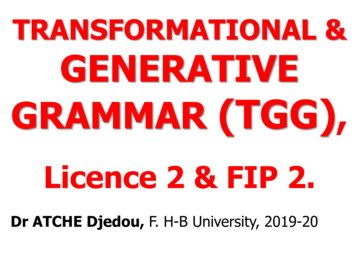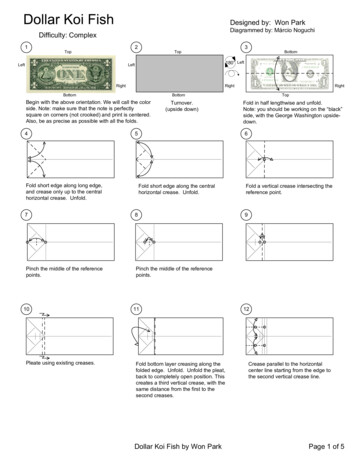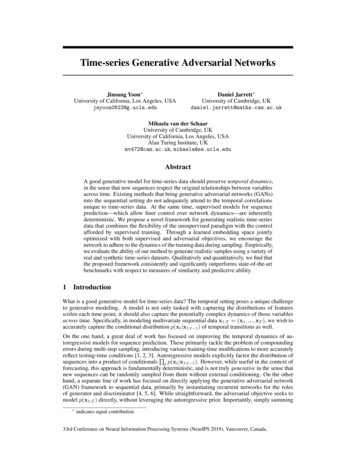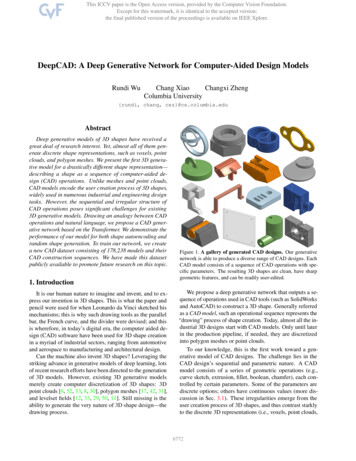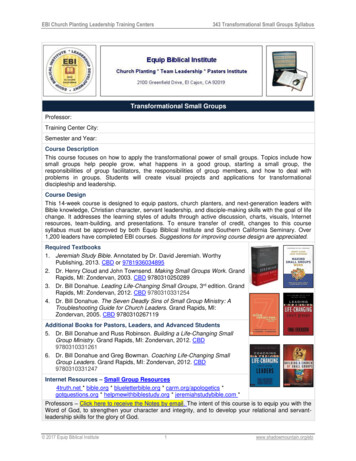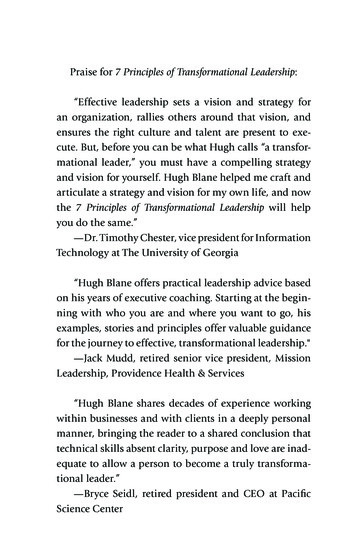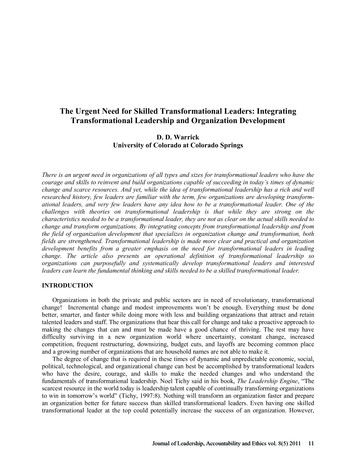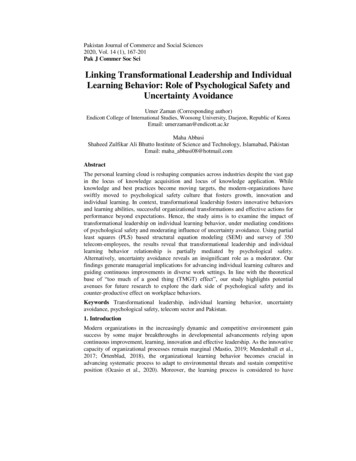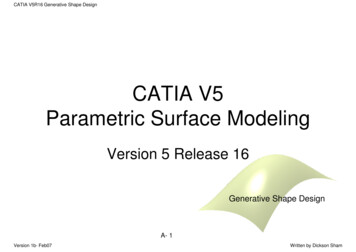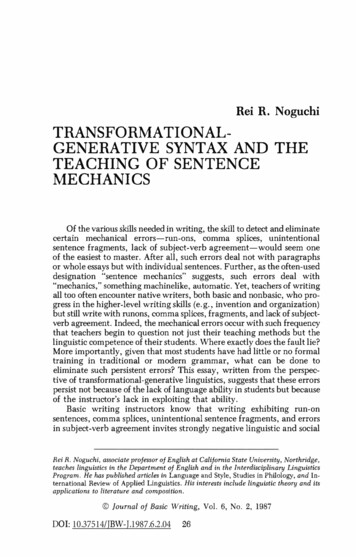
Transcription
Rei R. NoguchiTRANSFORMATIONAL GENERATIVE SYNTAX AND THETEACHING OF SENTENCEMECHANICSOf the various skills needed in writing, the skill to detect and eliminatecertain mechanical errors-run-ans, comma splices, unintentionalsentence fragments, lack of subject-verb agreement-would seem oneof the easiest to master. After all, such errors deal not with paragraphsor whole essays but with individual sentences. Further, as the often-useddesignation "sentence mechanics" suggests, such errors deal with"mechanics," something machinelike, automatic. Yet, teachers of writingall too often encounter native writers, both basic and nonbasic, who pro gress in the higher-level writing skills (e.g., invention and organization)but still write with runons, comma splices, fragments, and lack of subject verb agreement. Indeed, the mechanical errors occur with such frequencythat teachers begin to question not just their teaching methods but thelinguistic competence of their students. Where exactly does the fault lie?More importantly, given that most students have had little or no formaltraining in traditional or modern grammar, what can be done toeliminate such persistent errors? This essay, written from the perspec tive of transformational-generative linguistics, suggests that these errorspersist not because of the lack of language ability in students but becauseof the instructor's lack in exploiting that ability.Basic writing instructors know that writing exhibiting run-onsentences, comma splices, unintentional sentence fragments, and errorsin subject-verb agreement invites strongly negative linguistic and socialRei R. Noguchi, associate professor of English at California State University, Northridge,teaches linguistics in the Department of English and in the Interdisciplinary LinguisticsProgram. He has published articles in Language and Style, Studies in Philology, and In ternational Review of Applied Linguistics. His interests include linguistic theory and itsapplications to literature and composition. Journal of Basic Writing, Vol. 6, No. 2, 1987DOI: 10.37514/JBW-J.1987.6.2.0426
criticism. Many in society, often in positions of power, view suchmechanical errors as signs of illiteracy, if not mental incompetence. Giventhe constraints of the reader-writer relationship and the difference between writing and speech, instructors will have more success changingthe habits of the offending writers rather than the habits of a censoriouspublic. Yet, eliminating mechanical errors has proved a formidable taskfor both students and teachers of writing. Although the traditional handbooks offer "rules" to aid in the correction of these errors, the rules arein actual practice difficult to apply, especially if students have had little or no formal study of grammar. For example, traditional handbooksinstruct students to make the verb of a sentence agree in number withits subject. But, this seemingly simple and straightforward rule is impossible to apply if students do not know what the term "subject" meansor how to locate a subject in an actual sentence. Another seemingly accessible handbook rule states that a fragment is not a sentence and, hence,cannot be punctuated as one. For students to understand and apply thisrule, however, they must first understand what is meant by "sentence";but to understand what is meant by a sentence, they must understandwhat an independent clause is, and to understand the latter, they mustunderstand what a subject and verb are.For writing instructors, the path proves equally tortuous. To helpstudents eliminate, for example, sentence fragments, instructors mighttry explaining the concept of fragment. But to do so inevitably leads tothe concept of sentence, which, in turn, leads to the concepts of independent clause, subject, and verb. As most writing teachers can attest, thesame tortuous route applies in explaining the concepts of run-on sentencesand comma splices. The crux of the problem is obvious: much of conventional instruction to correct run-on sentences, comma splices, sentencefragments, and errors in subject-verb agreement makes reference notmerely to opaque grammatical terms but, worse still, to opaque grammatical terms which interlink in their definitions with other equallyopaque grammatical terms.To help students correct sentence mechanics, writing instructors needa method which eliminates the dovetailing of grammatical concepts, onewhich enables students to identify the relevant grammatical categoriesindependently of other grammatical categories. The standard, or classical,model of transformational-generative grammar can serve as a significantpedagogical aid here.1 The model posits two levels of representation forsentences, an abstract deep structure of meaning relationships and a concrete surface structure of realized sentences. The surface structure isderived from the deep structure by a set of rules, or transformations. AsI will demonstrate shortly, it is the transformational part which provesuseful in the correcting of sentence mechanics. What makes the transformational part particularly useful is that transformational rules are sensitive to various syntactic categories.27
Take, for example, the rule of Tag-Formation, which relates the aand the b sentences in each pair of sentences below:la. John can swim.b. John can swim, can't he?2a. The neighbors will be moving to Los Angeles.b. The neighbors will be moving to Los Angeles, won't they?3 a . The car with the mag wheels and the tinted windows has beenwashed.b . The car with the mag wheels and the tinted windows has beenwashed, hasn't it?4a. Betty studied her chemistry last night.b. Betty studied her chemistry last night, didn't she?If given only the a sentences above, native speakers of English can easilytransform them into the corresponding b sentences-that is, into the tagquestions. Writing instructors can readily demonstrate this both tothemselves and to their students by reading the a sentences in class andhaving their students orally produce the corresponding tag-questions.But how is it possible that native speakers of English can performsuch transformations so effortlessly? Specially, how do native speakerscreate the "tags" (e.g., the can't he, won't they, hasn't it, didn't she) atthe ends of the original declarative sentences and thereby convert thedeclarative sentences into tag-questions? Native speakers certainly havenot memorized the corresponding tag-question for each declarativesentence. Rather, they have internalized a rule, here the rule of TagFormation, which enables them to transform each declarative sentenceinto the corresponding tag-question. While linguists have formulated TagFormation in different ways, 2 most agree that the rule essentially copiescertain constituents of a sentence to create the tag at the end. The grammatical elements which get copied are the first auxiliary verb (if noneoccurs, a form of do is added instead), the verb tense, the negative notin contracted form (if the sentence is positive), and the subject nounphrase in pronominal form. Although Tag-Formation is a complex ruleinvolving several operations, all native speakers of English have an implicit knowledge of the rule; otherwise they would be unable in dailylife to transform the a sentences in 1-4 into their corresponding tagquestions. This fact is highly important, for if native speakers alreadyknow the rule of Tag-Formation (although they may not be able to stateit explicitly in the manner linguists do), instructors do not have to teachthe rule. After all, instructors cannot teach students what they alreadyknow. A second and more important point follows: if native speakersof English already know the rule of Tag-Formation, they must also knowthe syntactic categories involved in the rule; that is, native speakers ofEnglish, whatever their formal background in grammar, already havean underlying knowledge of such syntactic categories as sentence, auxiliary verb, tense, negative, and (subject) noun phrase. (How else couldthey correctly identify and copy these elements in the tag?) Stated in asomewhat different way, even though students may lack the ability to28
assign traditional labels to certain syntactic categories, they neverthelessunconsciously know what they are. It is precisely this unconsciousknowledge of syntactic categories that writing instructors should exploitin the teaching and correcting of sentence mechanics.Yet, just how can instructors exploit this underlying knowledge ofsyntactic categories? The correction of sentence fragments can serve asan illustration. To understand the notion of sentence fragment, studentsneed to make use of the concept of sentence (i.e., a sentence fragmentis only a "part" of a sentence). But herein lies a pedagogical problem.How can writing instructors introduce the concepts of sentence withoutalso invoking such dovetailing concepts as independent clause, subject,and predicate? The solution is to bypass these latter concepts and to exploit directly the student's implicit underlying knowledge of the syntactic category "sentence." That students already have an intuitiveknowledge of what constitutes a sentence is clearly evident in their abilityto use the Tag-Formation rule to transform any declarative sentencee.g., the a sentences in 1-4 above-into its corresponding tag-question.Put in a slightly different way, Tag-Formation operates on onlydeclarative (and imperative) sentences, not fragments . If this is so, therule will operate on sentences such as la, 2a, 3a, and 4a but not onsequences such as:5. Although John will stay home.6. Whatever was bothering the neighbors.7. Who saw that she had been trying.8. Waiting for the show to begin.As suggested earlier, if students are asked to transform sentences likela, 2a, 3a, and 4a into their corresponding tag-questions, they can easily perform the transformation; however, with sequences like 5-8, theywill find the task impossible since Tag-Formation works only fordeclarative (and imperative) sentences, not fragments. Put in the mostsimplistic terms, if a sequence of words can be transformed into a propertag-question, it is a sentence; if not, it's a fragment. 3 Worth emphasizing here is that students do not need to know how to formulate the TagFormation rule to realize this fact; neither is it necessary for instructorsto introduce transformational-generative linguistics as background. Yet,if instructors can get students to recognize the simple fact that tagquestions cannot be formed from fragments, then students will have aneasily and always available means of testing for fragments-and withoutfirst having to undergo time-consuming and often confusing formal instruction in what constitutes a sentence, independent clause, subject,predicate, and so on.The Tag-Formation rule can also help identify and correct run-onsentences and comma splices. This is so because, as suggested above, theTag-Formation rule differentiates between two general types of wordsequences: a sentence and a nonsentence. Technically speaking, neithera run-on nor a common splice is a bona fide sentence since each consistsof two or more sentences incorrectly joined as one sentence. The valueof the Tag-Formation rule is that it can be utilized to determine the29
"sentencehood" of the whole sequence (i.e., the run-on or comma splice)and its parts. For purposes of demonstration, instructors might ask theirstudents to write the proper tag-questions for such sequences as thecomma splice in 9 below, and the run-on in 10:9. Jerry decided to become an accountant, Susan became a doctor.10. The guard made his nightly rounds all seemed in order.With sequences like 9 and 10, students either will be unable to producea proper tag-question (in which case they will have strong evidence thatthe sequences are nonsentences), or they will produce the following sequences:11. Jerry decided to become an accountant, Susan became a doctor,didn't she?12. The guard made his nightly rounds all seemed in order, didn't it?If asked to read sequences 11 and 12 aloud, however, most students willfind them unnatural as individual sentences because one part sounds likea question and the remaining part does not. If requested to do so, moststudents can also separate the question part from the nonquestion part(it's generally easier to separate two unlikes than two likes). The separation point, of course, is the point where the run-on or comma splice actually occurs. Ignoring punctuation and capitalization, sequences 11 and12 will thus divide into two parts:13. Jerry decided to become an accountant I I Susan became a doctor, didn't she?14. The guard made his nightly rounds I I all seemed in order, didn't it?To demonstrate further that run-ons and comma splices incorrectly joinsentences, instructors should ask students to form a tag-question fromthe remaining part (i.e., the first, or nonquestion, part) of 13 and 14.Again, most students will be able to do so because this part, like the secondpart, is also a sentence.The ability to use the Tag-Formation rule as a testing device can,of course, be highly valuable in the actual correction of run-ons and commas splices. Logically, the detection of run-ons and comma splices isnecessarily prior to correction. The advantage of using the method outlined above is that if students are instructed not to join sentences withmerely commas or no punctuation at all, they can use the Tag-Formationrule to identify just what parts of suspect sequences are individualsentences and then insert the correct form of punctuation. If the lackof a semicolon is the mechanical error, an added boon is that the methodcan be used to demonstrate (or verify) that a semicolon, in its primaryfunction, should join sentences, not fragments.Lastly, the use of underlying syntactic knowledge can help identifyand correct errors in subject-verb agreement. With errors in subject-verbagreement, the primary source of error lies in locating the subject of thesentence-that is, the noun phrase (more specifically, the noun) constituent with which the verb agrees in number. To simplify matters here,I exclude from discussion collective noun phrases; noun phrases following the expletive, there; and compound noun phrases joined by or; all30
of which require special rules. I make these exclusions in order to focuson the more general type of error, namely, errors dealing with the simple misidentification of the subject. This kind of error usually occursbecause some phrase (e.g., prepositional phrase, participial phrase) orsome subordinate clause intervenes between the main clause subject andits verb. The following sentences (where the symbol * designates anungrammatical sentence) exemplify this type of error:15. *The use of electronic security devices have increased in the lastdecade.16. *The company which operated several branch offices in NewYork, Chicago, and Los Angeles were going bankrupt.In the two sentences above, the sources of the agreement errors are theintervening prepositional phrase (i.e., of electronic security devices) in15 and the intervening relative clause (i.e., which operated several branchoffices in New York, Chicago, and Los Angeles) in 16.Conventional instruction to eliminate agreement errors such as thosein 15 and 16 is, however, fraught with difficulty. To help eliminatesubject-verb agreement errors caused by intervening constructions,writing instructors might, for example, try explaining that prepositionalphrases, or more accurately, objects of prepositions, can never serve assubjects of sentences; however, this leaves the onerous task of explainingjust what constitutes a prepositional phrase or an object of a preposition, and, inescapably, what constitutes a preposition (not to mentionwhat constitutes a subject). If instructors attempt to explain that relativeclauses, or more specifically, noun phrases in relative clauses, also cannot serve as subjects of main clauses, an even greater store of proliferatingcategories lies on the horizon (e.g., main clause, dependent clause, relativepronoun, subject, verb, noun phrase).To break the chain of interlinking categories, writing instructors canagain make use of the implicit syntactic knowledge of their students. Sincethe Tag-Formation rule makes reference to the notion of subject (i.e.,it's the subject which gets copied in pronominal form in the tag), therule would seem to provide an effective means of identifying subjectsof sentences. All one needs to do to locate the subject of a sentence isto form the derivative tag-question, locate the pronoun (or simply, thelast word) in the tag, and determine which word in the sentence the pronoun refers to (i.e., "stands for"). However, a discomforting problemmay arise here. In sentences like 15 and 16 above, the Tag-Formationrule will not always work in identifying subjects for all students. For example, given the grammatical declarative sentences 17a and 18a below,students will produce the corresponding grammatical tag-questions 17band 18b:17a. The use of electronic security devices has increased in the lastdecade.b. The use of electronic security devices has increased in the lastdecade, hasn't it?31
18a. The company which operated several branch offices in NewYork, Chicago, and Los Angeles was going bankrupt.b . The company which operated several branch offices in NewYork, Chicago, and Los Angeles was going bankrupt, wasn't it?. However, if students begin unwittingly with the ungrammatical sentences15 and 16, which I will repeat as 19a and 20a below, they are likely toproduce unwittingly the ungrammatical tag-questions 19b and 20b:19a. *The use of electronic security devices have increased in the lastdecade.b. *The use of electronic security devices have increased in the lastdecade, haven't they?20a . *The company which operated several branch offices in NewYork, Chicago, and Los Angeles were going bankrupt.b. *The company which operated several branch offices in NewYork, Chicago, and Los Angeles were going bankrupt, weren'tthey?In 19b, the pronoun they in the tag substitutes not for the subject usebut incorrectly for devices (the object of the preposition of); in 20b, thepronoun they substitutes not for the subject company but apparentlyeither for offices (the direct object of the relative clause) or for New York,Chicago , and Los Angeles (the com pound objects of the preposition in).The errors in forming the correct tag-question in 19 and 20 raise atleast two important questions. First, do such errors mean that studentsdo not really know how the Tag-Formation rule operates and, morespecifically, do not know what the subjects of sentences are? The answerin both cases is no. Because of the greater length and complexity ofdeclarative sentences 19a and, particularly, 20a, many writers-includingsophisticated ones-will fall prey to errors in linguistic performance (notlinguistic competence) , more specifically, to limits of short-term memory.Producing the correct pronoun in the tag of a tag-question requires,among other things, holding the subject of the sentence in memory untilthe end of the sentence, a task which becomes more difficult as otherconstructions, particularly other noun phrases, increase the distance between the subject and the tag. (Instructors of writing can demonstrateto themselves and to their students that the underlying knowledge of subjects is still there with 19a and 20a by deleting the intervening constructions, changing the verbs have increased and were going to increasedand went, respectively, and then having the students form the tagquestions.)The second question is more pedagogical. If Tag-Formation does notalways work in identifying subjects, particularly in long and complexsentences, is there some other means that writing instructors can use asa backup-or as an initial resource-to help students identify subjects?For example, let us say that a student has unwittingly produced theungrammatical tag question in 19b and insists that devices is the subjectof the sentence since that is what the they in the tag refers to. An instructor who recognizes that 19a and 19b are ungrammatical versions32
of 17a and 17b, respectively, would insist just as strongly that the subject is use, not devices, since use is what it in the grammatical tag-question17b refers to. Because the instructor and student apply the Tag-Formationrule to different declarative sentences-the student to 19a and the instructor to 17a-they end with different results. Is there any way toresolve the issue?Fortunately, in such situations, instructors and their students can useas a resource another question formation rule of transformationalgenerative linguistics, namely, the Yes-No Question rule. This transformational rule, known implicitly by all native speakers of English,transforms declarative sentences to questions of the following form:2la. The gambler could have lost all of his money already.b. Could the gambler have lost all of his money already?22a. The witness whom the police believe was threatened refuses totestify.b. Does the witness whom the police believe was threatened refuseto testify?23a. Yesterday afternoon, Martha bought a new stereo.b. Yesterday afternoon, did Martha buy a new stereo?24a. My friends from Canada, Joseph and Sandy, have been thinking about moving to Florida.b. Have my friends from Canada, Joseph and Sandy, been thinking about moving to Florida?25a. Although having a bad cold, the child is planning to go to theparty.b. Although having a bad cold, is the child planning to go to theparty?As evidenced from the illustrative sentences above, the Yes-No Questionrule moves the first auxiliary verb (if there is one) and verb tense of themain clause to the immediate left of the subject noun phrase. If no auxiliary verb occurs in the main clause, as in 22a and 23a, another transformational rule known as Do-Support inserts a do form to take the placeof the "missing" auxiliary verb. Again, neither the Yes-No Question rulenor the Do-Support rule need be taught formally in the classroom sinceall native speakers of English not only know these rules already but constantly use them in daily speech to produce grammatical yes-no questions.What is significant about the Yes-No Question rule for the problemat hand is that it specifically makes reference to the subject noun phraseof a sentence. This means that students can use the Yes-No Question ruleas another means to identify subjects. Specifically, after the applicationof the Yes-No Question rule (and, if necessary, the Do-Support rule) toa declarative sentence, the subject of a sentence will be that noun phrasewhich occurs to the immediate right of the auxiliary verb (or the inserteddo form if no auxiliary verb occurs). Given that it is the auxiliary verbthat always undergoes the movement (and not the subject), the locationof the subject can be stated in a somewhat unorthodox yet simpler fashion:the (simple) subject of a sentence is the noun (i.e. , "person, place, or33
thing") which stands to the nearest right of the word that has moved(or the nearest right of the do form if it has been inserted). Thus, insentences 21-25, the subject nouns (of the main clauses) are, respectively, gambler, witness, Martha, friends, and child.While identifying subjects with the Yes-No Question rule does havethe disadvantage of instructors having to explain what a noun phraseor a noun is, the rule has some clear benefits. For one, the use of therule can resolve the problem encountered earlier in determining the actual subject of the sentences in 17 and 19 and other similar sentences.If students transform the declarative sentences in 17a and 19a not intotag-questions but into yes-no questions, the resulting questions would be,respectively:26. Has the use of electronic devices increased in the last decade?27. *Have the use of electronic devices increased in the last decade?Disregarding for the moment the ungrammaticality of 27, the application of the Yes-No Question rule here shows clearly that use and notdevices is the actual subject of the sentence since use is the noun whichstands to the nearest right of the moved auxiliary verb have. Transforming more complex sentences such as 18a and 20a results, respectively,in the following yes-no questions:28. Was the company which operated several branch offices in NewYork, Chicago, and Los Angeles going bankrupt?29. *Were the company which operated several branch offices in NewYork, Chicago, and Los Angeles going bankrupt?Here (again ignoring ungrammaticality), the application of the Yes-NoQuestion rule shows that company is the subject, not offices nor the compound noun phrase New York, Chicago, and Los Angeles.The Yes-No Question rule, however, provides a still greater benefitwith respect to resolving the subject-verb agreement problem. Becausethe Yes-No Question rule places the verb which carries number agreement and the subject back to back, students can perceive more clearlyif indeed the verb and its subject agree in number. Put in another way,because the Yes-No Question rule can radically shorten the distance between the subject and the number-carrying verb, students are less proneto performance errors, such as lapses in short-term memory. Thus, if givensentences 27 and 29, especially in contrast to sentences 26 and 28, studentswill more clearly see not only the ungrammaticality of sentences 27 and29 but also the reason why.4 Again, none of this requires students tohave prior schooling in grammar.As with any method employed to attack persistent mechanical errors, the method of exploiting underlying syntactic knowledge has somedrawbacks. It may not work in all cases in all dialects, and, obviously,it will not work for nonnative speakers of English, or at least, nonnativespeakers with a weak command of the language. The method, however,does have some decided advantages. It works for most standard speakersof English; it requires no formal training in traditional or transformational-generative grammar (all an instructor needs are sample34
sentences and fragments for demonstration purposes); it can be employedfrom the elementary school level to the college level; it can be used bothin a classroom setting and in individual tutoring sessions (it can be taughtvery easily to student tutors); it can be expanded to include other matters of sentence mechanics (e. g., explaining and applying punctuationrules which make reference to independent and dependent clauses). Lastly, and perhaps most important at least for basic writers, the methoddevelops not only self-reliance but also self-confidence because it emphasizes what students already know rather than what they do not. Themethod is, in other words, intuitive rather than theoretical. Indeed, ifanything, the method brings to the surface the immense, often untapped(and often unappreciated), store of linguistic knowledge that studentsbring to the classroom everyday.Notes1By the "standard" or "classical" model of transformationalgenerative grammar, I mean that model of language presented by Chomsky in Aspects of the Theory of Syntax. Those wishing a cogent historyof the development and reception of transformational-generativelinguistics in the United States can consult the two books by Newmeyerlisted in the bibliography.2 For a classical version, see, for example, the formulation in Akmajian and Heny 1-11, 202-18. Further discussion and other treatments ofTag-Formation appear in Arbini; Huddleston; Cattel; and Culicover131-43.3 I use the term "simplistic" deliberately here, for some notable exceptions do occur. For example, from the fragment "A nice day," wecan derive "A nice day, isn't it?" However, instructors can utilize suchexamples to reinforce the idea that all tag-questions derive from underlying declarative sentences and not parts of them. By undoing the effectsof Tag-Formation and other transformational rules (e.g., deleting the-n 't and putting the copied elements of the tag back into their originalpositions), instructors can demonstrate that "A nice day, isn't it?" actually derives from "It is a nice day" (the underlying declarative sentence)and not from "A nice day" (a part of the underlying declarative sentence).The derivation of "A nice day, isn't it?" proceeds thus: "It is a nice day"(underlying declarative sentence) to "It is a nice day, isn't it?" (derivedsentence after the Tag-Formation rule has applied) to "A nice day, isn'tit?" (derived sentence after another rule has deleted it and is in the mainclause). This derivation, incidentally, reveals an exception to thesimplified description of the Tag-Formation rule given in the text. TagFormation also copies forms of the main verb be in the tag if these beforms have no accompanying first auxiliary verb (e. g., "Bill is happy,isn't he?" vs. "Bill could be happy, couldn't he?") . Another notable exception involves sentences like "I believe (that) John will go to Las Vegas,"where the appropriate tag-question seems to be "I believe (that) Johnwill go to Las Vegas, won't he?" rather than the expected "I believe (that)John will go to Las Vegas, don't I?" Yet, the fact that we can still derivean acceptable tag-question by copying elements from within the original35
sentence suggests that, if not the whole sentence, at least the embeddedclause (i.e., John will go to Las Vegas) is a sentence and not a fragment.Of interest here is that constructions like "I believe that . " (with thatbeing unstressed) can serve as another test of "sentencehood" since onlysentences (and not fragments) can be immediately embedded after them.To demonstrate this, the instructor might ask that students try to embedfragments like 5-8 immediately after "I believe that . " (Discerningreaders may notice that the sequence "A nice day" cannot occur in thisslot-hence, it is a fragment.) For a pragmatic explanation of whysentences containing cognition verbs (e.g., belie
TRANSFORMATIONAL GENERATIVE SYNTAX AND THE . Technically speaking, neither a run-on nor a common splice is a bona fide sentence since each consists of two or more sentences incorrectly joined as one sentence. The value of the Tag-Form
